This is my 2nd favorite Zelda game. The only one that beats it is Link's Awakening.
The Legend of Zelda: A Link to the Past Review Rewind
|
|
See PixlBit's Review Policies

On 04/13/2022 at 08:00 AM by Jamie Alston Link’s 16-bit debut still sticks the landing 30 years later. |

Yes.
If there’s ever a time I dread writing a review, it’s when my subject is a highly favored game that has received so much praise over the years that it’s a bit hard not to sound like I’ve just hopped aboard the nostalgic hype train at this point. Check any top 10 list of the best Super Nintendo games, and you’ll be hard-pressed not to find The Legend of Zelda: A Link to the Past floating somewhere within the top five, if not the number one spot. It’s a testament to its staying power in the minds of the gaming community at large. When I sat down to play this game for myself, I only had one question- is the game really that good? Yes. Yes, it is.
In a surprise to no one, you step into the tunic of Link- the hero on a mission to rescue Princess Zelda from the clutches of the evil wizard Agahnim. Zelda’s powers are the key to Agahnim freeing his master Ganon from the dark world so he can corrupt the light world to his wicked heart’s content. After receiving a telepathic plea for help from the princess in peril, Link sets off on a journey between two worlds.
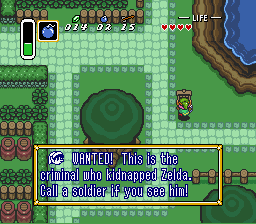
Nintendo’s premier designer, Shigeru Miyamoto, and his team balanced familiar gameplay elements from the first two Zelda games while making significant improvements that made for a superb experience. The game returns to the top-down overhead perspective used in the original Legend of Zelda (LOZ). However, Link’s sword attack was modified into an arc swing instead of a simple forward stab. Additionally, he now has a charged circular attack which allows him to fend off nearby enemies in any direction. Through the course of the game, Link steadily acquires the ability to dash, swim, and lift heavy objects that impede your progress.
The melee combat elements from Zelda II are also carried over, only better implemented. Although a bit of strategic positioning is still needed when combatting weapon-wielding enemies, doing so no longer requires expert precision. However, this doesn’t make the game laughably easy; there are plenty of dungeon enemies with their quirks you’ll need to exploit. But the combat mechanics never become dishearteningly unpleasant for all but the most elite players.
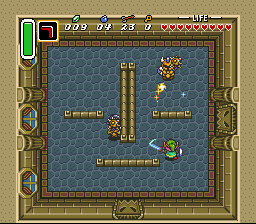
The game features an overworld map to mark Link’s current location and the areas he needs to visit. Palace dungeons are easily double the size of what they were in LOZ, this time featuring multiple levels that can take a good while to explore fully. Similarly, each dungeon holds a map and compass to help you find your bearings and pinpoint the location of the palace’s boss. However, the map only shows a basic layout without showing how exactly to reach the boss or various quest items. Much like in the first game, it gives just enough visual information while still letting players discover for themselves how to navigate each room.
Some of the larger rooms within most dungeons have upper and lower tiers and overpasses which Link can either walk under or climb up via nearby ladders. It adds a sense of depth to the overhead viewpoint without overcomplicating the layout of each dungeon. This was also the first game in the series to introduce parallel worlds as a significant gameplay mechanic and used it to good effect. Areas that initially seemed inaccessible required traveling to a nearby spot in the light or dark world where you could overcome the obstacle blocking your progress (bodies of water, elevated terrain, etc.). It was an engaging dynamic that kept me interested throughout the entire journey.
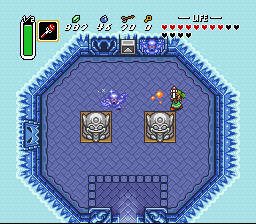
My favorite aspect of any Zelda adventure is the gradual collecting of quest items, even if I used only a few of them regularly. So I was pleased to see that most of the equipment in A Link to the Past served a valuable purpose in puzzle-solving and often had the added benefit of being a practical weapon in defeating certain enemies quicker than using the sword. One of my favorite items is the Hookshot- an invaluable tool for crossing gaps, collecting loot from afar, or keeping an enemy at bay. In addition, improvements were made on routine items like the bow & arrow, which now has its own allocated ammunition counter instead of costing rupees per shot.
NPCs are better integrated into the game’s world. Interacting with them served an integral role beyond just receiving cryptic clues or the occasional power-up. Since your actions between the light and dark worlds can deepen your interactions with certain NPCs, it helped the land of Hyrule to become more than merely a hub that joined the other areas together on a map. There are also more supporting characters of significance other than just Zelda herself. This was the game that began expanding the lore of Hyrule and its inhabitants. It was great seeing the beginnings of certain plot elements that would be cemented in subsequent games.
The audio presentation is nothing short of epic. Your quest begins with the familiar overworld theme, and item catch jingle retouched to take advantage of the Super Nintendo’s audio capabilities. But the game also had new compositions, such as the haunting orchestral strings when exploring palace dungeons or the surprisingly heroic dark world theme befitting of a stalwart protagonist like Link. I also appreciated the more minor details in the sound design, such as the subtle differences of rain falling when transitioning from outside to indoors or the sound of Link’s feet sloshing through shallow water.
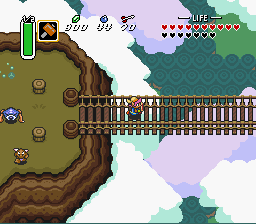
While you can save your game anywhere at just about any time, there are a few caveats. If saving your progress during any moment other than when at the “game over” screen, you’re forced to quit your current session and return to the title screen. You have four starting waypoints when resuming from a save file (three in the light world; one in the dark world).
While less stringent than in the previous Zelda games, it can still be a slog to travel back to where you were, depending on how far you need to travel (especially in the dark world). There is, however, a feature that allows for quick travel to additional locations in the light world via a bird you encounter later in the game. While it does require some minor side-questing to access the ability, it’s a handy feature that spares you the monotony of covering the same ground when journeying to the far corners of the world map.
A Link to the Past has the increasingly rare distinction of still holding up to the accolades received 30 years ago. Having only recently played this game in its entirety for the first time, I walked away from the experience genuinely impressed with the brilliant execution of design elements brought together to become something greater than the sum of its parts. It’s still one of the best video games ever made. It’s still a great time from start to finish. And most importantly, still readily available (via Switch Online subscription) to be enjoyed by newcomers and seasoned veterans of the series alike.







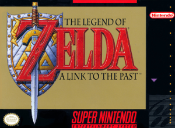

Comments